In my last blog, I said that if you’re not sure about the differences between the verbs do and make, you should start with do as your main option and learn ‘exceptions’ when you need make. The first occurs when you want to emphasise that you’ve created something new, as when you make a cake (reheating a frozen job doesn’t count) or make friends. The second use is all about influencing things, as I will try to explain below.
Making you smile
One way to talk about the people and pressures that influence our behaviour in English is to use an ‘Object + Infinitive’ phrase like She asked me to help. The same structure is used with many verbs related to causing things to happen and forcing people to act, including advise, invite and force. There are two little oddities that don’t need ‘to’ between the object and the verb: let for enabling and make for obligations, so your friendly supplier lets you use the product now but makes you pay later. You can summarise this use as make + Object + Base Verb, and it’s worth remembering because it’s not only people who make you do things; jokes make you laugh, dancing makes you sweat and cutting onions makes you cry.
Making you happy
If make can affect you on a basic, physical level, it’s no surprise that it’s regularly used for feelings. Different situations can make you feel happy, confused or angry, but since the verbs used to introduce these “feeling adjectives” (normally feel or be) are easy to guess, we often omit them, so success makes you happy and children make you tired. This time, the formula is make + Object + Adjective, and the adjectives are often comparative, too, as when the Beatles tell Jude to make it better.
With these two uses of make, together with the ‘creative’ use of the basic make + Noun which I set out in my last blog (https://secondlanguage.net/2022/01/19/what-to-do-with-do-and-make/), there’s no doubt that make is a key verb and you’re going to use it often in speaking. That said, I still maintain that do should be your default option, simply because doing covers a lot more meanings than just creating or influencing. If you reserve make as an ‘exception’ for the cases I mention, and use do for all the rest, you won’t go far wrong in my view.


